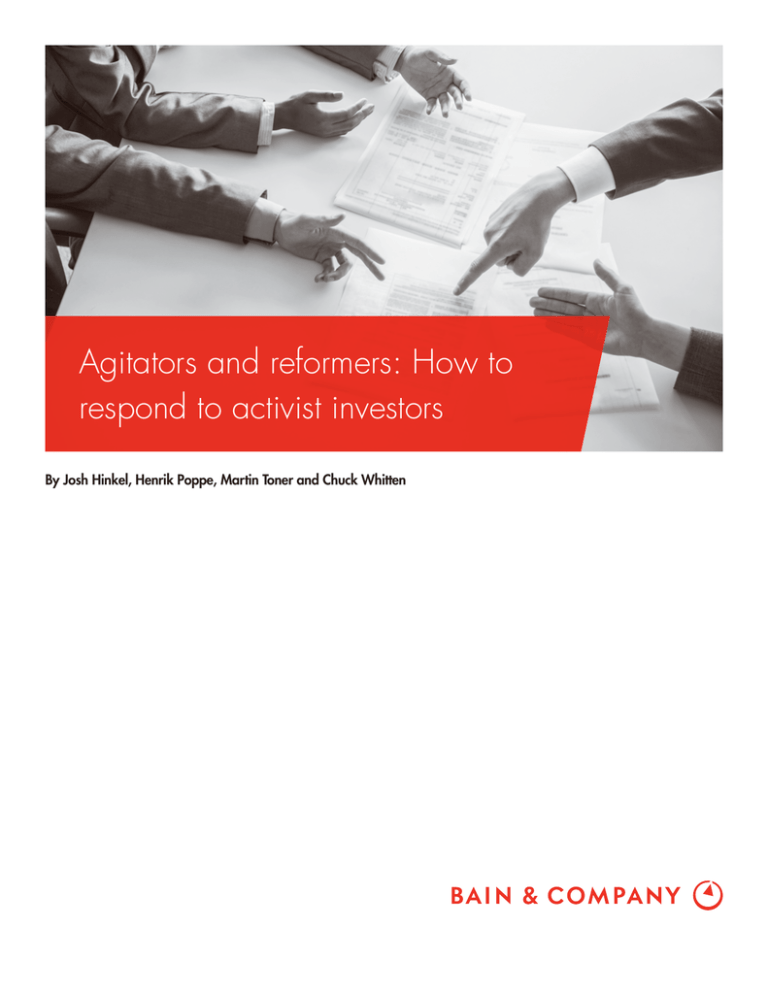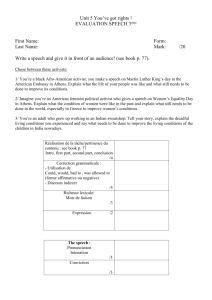
Agitators and reformers: How to
respond to activist investors
By Josh Hinkel, Henrik Poppe, Martin Toner and Chuck Whitten
Josh Hinkel, a partner in Bain’s Dallas office, is a member of the firm’s
Corporate Finance, Performance Improvement and Technology practices.
Henrik Poppe, a partner in Bain’s Oslo office, leads Bain’s Corporate Finance
capabilities in Europe, the Middle East and Africa and is a member of the firm’s
Mergers and Acquisitions and Private Equity practices.
Martin Toner, a partner in Bain’s New York office, is a member of the firm’s
Corporate Finance, Mergers and Acquisitions and Strategy practices.
Chuck Whitten, a partner in Bain’s Dallas office, is a member of the firm’s
Corporate Finance, Strategy, Performance Improvement and Technology practices.
The authors would like to thank David Harding, Matthias Meyer and Travis Wibracht
for their help in preparing the materials for this article.
Copyright © 2015 Bain & Company, Inc. All rights reserved.
Agitators and reformers: How to respond to activist investors
Arguably, the single best way to ruin a CEO’s day is to
report that an activist is on the phone and has just taken
a position in the CEO’s company.
activist’s investment thesis quickly—and then decide
where to cooperate, fight or negotiate.
How to get ready for the call? The first key step is to understand the common patterns and investment theses of
activists in general, and of those in your sector in particular. That will help you pressure-test your strategy and
your relationships with your investors. The other key
step is to create a comprehensive “break the glass in case
of emergency” plan. With a plan in place, you will not
be caught by surprise—and when an activist engages,
you and your team will know exactly what to do and who
will do it.
More and more CEOs are getting this call, as activist
investing has exploded in recent years. We examined
more than 400 activist engagements and found that the
targets are getting larger and the industries more diverse.
We also found that the activists’ attention is not limited
to so-called laggards; it includes a number of highperforming companies as well. In short, few, if any, management teams are immune to an activist challenge (see
the sidebar “Today’s activist landscape”).
What activists want
Bain’s analysis highlights the tough dilemma management teams face when they confront an activist. What
the activist says is often right, and activists’ overall track
record indicates that they do, on average, create shareholder value. But such a result can come at a high cost
for the organization. Moreover, many of the rewards are
front-loaded, leaving others to cope with the aftermath.
Hence the dilemma: A company cannot and should not
ignore activists, but it also should not immediately accept
or reject their ideas. It must be ready to evaluate the
Activist investment theses typically fall into seven categories
(see Figure 1). Most activists still lead off with a demand
for changes in corporate governance, such as new board
members or a new CEO. A minority—those whom many
companies view as agitators—have no publicly stated
thesis beyond that. They just want to stir the pot, in hopes
that somebody will address what they see as an undervalued stock.
Figure 1: Activists appear to add most value when their stated investment thesis includes a focused objective
Financial
Business strategy
Activists seek increased shareholder returns through
additional payouts to shareholders and changes in
the capital structure of the company.
For example:
– Distribution of special dividend
– Share buyback program
– Recapitalization or restructuring
M&A: Outright sale
Activists advise on the sale or
liquidation of the corporation.
For example:
– Pressure target to sell company
– Pressure target to liquidate
company
– Make a tender offer
Activists engage with management to adjust or
amend a business’s strategic goals and the means of
achieving current goals.
For example:
– Change business strategy or revise business plan
– Fix misaligned cost structure
– Seek change in top management
M&A: Portfolio reevaluation
Executive compensation
Activists often seek to rationalize compensation
with company performance or value that the
executive adds.
For example:
– Abolish or suspend stock options
– Appoint director of compensation standards
– Raise performance evaluation issues
Corporate governance
Activists push for changes in
governance, such as replacing the
CEO or board members.
– More than 75% of activist demands
involve nominating or replacing
directors
– Other common demands include
inspecting the books, repealing
the poison pill, amending bylaws
and conducting special meetings
Activists evaluate and recommend
changes to the target’s portfolio or
divisions.
For example:
– Pressure target to spin off divisions
– Oppose merger with another
company
– Oppose asset sale or divestiture
No explicit thesis
Activists' theses are not made public or
are identified only vaguely, such as
pursuing general engagement with
management to address what they see
as undervalued stock
Activist investors typically combine multiple theses in a given investment
Notes: Activist may pursue multiple theses (financial, business strategy, executive compensation or M&A) within a given deal; corporate governance and no explicit thesis are
only identified if there is no other strategy stated by the activist
Sources: S&P Capital IQ; Bain analysis
1
Agitators and reformers: How to respond to activist investors
Today’s activist landscape
Investor activism is growing rapidly. The number of deals rose an average of 34% a year between
2000 and 2014. Activist investors may now control close to 8% of total hedge fund capital.
Activists are targeting larger and more profitable companies. Target, Navistar, The Hartford and even
Apple have found themselves in activists’ sights in the past few years. Many of the activists’ targets
are profitable enterprises that are outperforming competitors.
Activist investing spans a wide range of industries. However, 70% of engagements fall into five categories:
consumer goods, financial services, technology, industrials and materials.
On average, activist engagements generate sustainable shareholder returns. The highest returns—
an average of 1.5 percentage points over industry indexes—occur in the first year. But the improved
performance lasts over a three-year period.
More engagements are nonhostile. In 2014, only about 40% of activist engagements were hostile.
So it is essential to unpack and evaluate the specific
investment thesis of the activist who is challenging your
company. But if you are simply reacting to the activists
once they arrive, it is likely too late.
The majority of activists are different, and might better
be called strategic reformers. They have a well-defined
program for reshaping the company they are pursuing.
That program may include specific changes in the company’s financial structure, business strategy and executive
compensation. It may propose the sale of the entire
enterprise or reevaluation of the business portfolio.
Strategic reformers’ demands are often carefully researched
and highly detailed. When the activist firm Starboard
Value engaged with the restaurant company Darden,
its diagnosis and prescription ran to nearly 300 pages,
including plans for real estate sales, franchising and
asset spin-offs.
Preparing in advance
The plan you put in place before the activist calls should
anticipate what they are likely to say, and it should lay
out your initial talking points.
Stress-test your strategy. Long-term value creation is a
function of fundamental performance. Most successful
companies have a sound strategy linked to specific objectives and measured by total shareholder return. A company that creates a sustainable competitive advantage,
executes well and reinvests to solidify its strategy will
find that its share price accurately reflects its value. That
is critical: If there is no arbitrage to be had, most activists
will hunt elsewhere.
A growing number of activist engagements are falling
into the strategic reform category, as our study indicates.
The study also shows why understanding the activist’s
demands is so important: Outcomes depend heavily on
the activist’s investment thesis. Strategic reformers as
a group typically produce significantly better returns
than others. Those who propose the sale of a company
or another M&A–based strategy tend to turn in the best
results of all. By contrast, the agitators—those with no
explicit investment thesis or pure corporate-governance
issues—produce little or no differential return compared
to industry indexes.
But you will need to stress-test your strategy against the
common activist plays in your industry. Ask yourself:
Are we underperforming against our peers in key operational metrics? Is our management compensation
congruent with company performance? Ask similar
2
Agitators and reformers: How to respond to activist investors
are monitoring activists and looking for vulnerabilities
across the most common activist theses. If you are passive
in your dealings with investors—if you simply adopt a
“the market will figure it out if we stick to our knitting”
approach—you are vulnerable.
questions about the value of your business portfolio—
would it be worth more broken up into its constituent
parts?—and about the strength of your balance sheet. If
you monitor activist investments closely, especially in your
own industry, you will find that much of what they look
at is highly predictable. And if you pose the same questions an activist would ask, you can take action before you
are confronted with an activist. When McGraw-Hill faced
restructuring demands from activist investor Jana Partners,
for example, it could announce it was already pursuing
a complete portfolio review and share repurchase plan.
The company thus avoided a costly proxy battle and
settled with Jana for one additional seat on the board.
Create your emergency plan. Prepared companies also
ensure that protocols for dealing with activists are in
place. When an activist surfaces, response teams know
who they are and what their role is. They know the activist
landscape, and they have the necessary resources at their
disposal. They are prepared to do the required research,
evaluate the activist’s thesis and develop the necessary
communications plans (see the sidebar “What to remember when an activist shows up”).
Solidify your investor relations. Well-prepared companies
complement a robust strategy with a proactive approach
to investor relationship management (IRM). A strong
IRM system includes five critical parts:
1.
A grounded, realistic internal valuation based on
the company’s current strategic and financial trajectory. No “hope casting” or overgenerous assumptions.
2.
An understanding of how that internal valuation
compares with existing market valuation—and what
accounts for any gap.
3.
An investor targeting plan that focuses management
attention on the most critical investors, meaning
those who can meaningfully move the stock and are
receptive to the company’s strategy and messaging.
4.
An equity marketing message that tailors the entire
mix and share of voice to the target investors and
the outcome you want to achieve with them.
5.
A repeatable, cross-functional business system that
delivers against investor objectives as measured by
milestones, initiatives and key performance indicators.
Breaking the glass: Engagement
Once the activist firm makes its move, a well-prepared
company puts its plan into action. It evaluates the activist,
engages and works toward a favorable settlement. It
communicates relentlessly with key stakeholders to
make sure it has their support.
Understand who this activist is and what the activist firm
brings to the table. Activist investors come in different
shapes and sizes. They have characteristic styles, objectives and investment theses. The response team needs
to dig deep into this particular activist’s history and modus
operandi, evaluate the investment thesis dispassionately
and propose possible courses of action. When Nelson
Peltz and Trian Fund Management took a position in
Heinz, the management team initially fought the initiative and wound up in a proxy war. When the war ended,
Peltz joined the Heinz board and supported management
as it executed a turnaround. Heinz’s CEO at that time,
William Johnson, became a close business confidant of
Peltz. Heinz ended up rewarding its shareholders, and
Johnson now works with Peltz to help other companies
find value.
Again, put your IRM system through a stress test. How
well do investors understand your strategy and valuecreation plan? What unexploited opportunities might
activists spot in your business? Are shareholders dissatisfied? A robust IRM system offers both a deterrent
and a response to activists: It aligns intrinsic value with
market value, eliminating arbitrage, and it enables a
company to mobilize shareholder support. But even
companies with robust systems should ensure that they
Engage the activist early and often. Many activists—
particularly strategic reformers—avoid a hostile approach.
They accumulate shares, contact the company either
publicly or privately, and sit down to negotiate. In an
ideal situation, a company manages these negotiations
to a favorable conclusion. Effective leaders start by listening closely to the activist’s concerns, keeping the
discussion private whenever possible. They avoid confron-
3
Agitators and reformers: How to respond to activist investors
What to remember when an activist shows up
Activists can be shorter-term oriented. Icahn Enterprises pushed Apple to return $150 billion of capital
to shareholders in the form of share buybacks, despite Apple management’s stance against such
an action.
Activists may focus on specific people. Starboard Value targeted Darden Restaurants CEO Clarence
Otis Jr. and removed him from his position in July 2014.
Activists may not engage directly with the company. Activist MMI Investments rebuffed attempts by
Checkpoint Systems to engage privately on MMI’s involvement, instead choosing to send a public letter
outlining its investment thesis and demands.
The public may side with the activist. In one case, the CEO’s compensation package exceeded the peer
group median by 325% from 2004 to 2010, damaging public perception.
Engagements change quickly. Darden’s sale of Red Lobster against activists’ desires launched Starboard
into a campaign against Darden leadership.
Engagements take real effort. Air Products engaged in active dialogue and relationship with Pershing
Square Holdings across a number of issues related to finance, strategy and governance.
Activists do not always act alone. Relational Investors partnered with the California State Teachers’
Retirement System to engage Occidental Petroleum on executive compensation.
tation through careful and thorough negotiation. They
aim to reach a common ground based on solid facts
and analysis. This kind of negotiation often ends in a
favorable settlement between the company and the activist.
This prescription sounds obvious, but in our experience
many companies fail to take the activist’s thesis seriously.
Instead they respond defensively, or with generalities.
That approach not only does not work; it misses an opportunity to increase the company’s value.
Of course, not every situation fits that ideal. The company may believe that the activist’s claims are unreasonable or counterproductive. Activists may choose to take
their demands public and drum up support from stakeholders. They may threaten or actually launch a proxy
contest. In these situations the proxy contest may be
decisive, or it may precipitate a late-in-the-game settlement. The outcome is often unfavorable from management’s point of view.
Once you have decided on the response, you need to
communicate it effectively to key stakeholders and line
up their support. This group naturally includes the
board and critical investors; it also includes key customers
and suppliers, employees and the general public. You
ignore any of these constituencies at your peril.
———
The arrival of an activist may always spoil a CEO’s day.
But with the right advance planning, a company can
avoid the dilemma we described and can be ready to
react quickly with a well-thought-out response.
Decide on the right course of action—and communicate
it to key stakeholders. You have somewhere between 30
and 90 days to prepare a detailed response. You must
meet the activists on their own terms, with facts and
analysis that are as detailed and well supported as theirs.
4
Shared Ambit ion, True Results
Bain & Company is the management consulting firm that the world’s business leaders come
to when they want results.
Bain advises clients on strategy, operations, technology, organization, private equity and mergers and acquisitions.
We develop practical, customized insights that clients act on and transfer skills that make change stick. Founded
in 1973, Bain has 51 offices in 33 countries, and our deep expertise and client roster cross every industry and
economic sector. Our clients have outperformed the stock market 4 to 1.
What sets us apart
We believe a consulting firm should be more than an adviser. So we put ourselves in our clients’ shoes, selling
outcomes, not projects. We align our incentives with our clients’ by linking our fees to their results and collaborate
to unlock the full potential of their business. Our Results Delivery® process builds our clients’ capabilities, and
our True North values mean we do the right thing for our clients, people and communities—always.
Key contacts in Bain’s Mergers & Acquisitions/Corporate Finance practice:
Americas:
Josh Hinkel in Dallas (josh.hinkel@bain.com)
Martin Toner in New York (martin.toner@bain.com)
Chuck Whitten in Dallas (chuck.whitten@bain.com)
Asia-Pacific:
Thomas Olsen in Jakarta (thomas.olsen@bain.com)
Harshveer Singh in Singapore (harshveer.singh@bain.com)
Europe,
Middle East
and Africa:
Richard Jackson in Amsterdam (richard.jackson@bain.com)
Henrik Poppe in Oslo (henrik.poppe@bain.com)
For more information, visit www.bain.com








